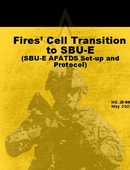
The Center for Army Lessons Learned leads the Army Lessons Learned Program and delivers timely and relevant information to resolve gaps, enhance readiness, and inform modernization.

Downloads: 173
Hits: 173
This article discusses the learning experience of the 2BCT, 101st Airborne (Air Assault) Fires’ Cell transition to SBU-E. It provides rudimentary... read more
This article discusses the learning experience of the 2BCT, 101st Airborne (Air Assault) Fires’ Cell transition to SBU-E. It provides rudimentary procedures to help other units more quickly integrate it into their own systems and processes and best practices developed by the unit during their operations validating the new Secure But Unclassified-Encrypted (SBU-E) Kill Chain starting from BN FSE (MUOS Unclassed-Digital) through our BDE AFATDS boxes (SBU-E) to DIV Fires (SIPR) as well as to the FAR’s FDCs (SBU-E) and down to the guns.
less

Downloads: 192
Hits: 192
In the fast-paced environment of large-scale combat operations (LSCO), managing HR is a critical yet often overlooked aspect of mission success. During the... read more
In the fast-paced environment of large-scale combat operations (LSCO), managing HR is a critical yet often overlooked aspect of mission success. During the JPMRC exercise, the absence of a dedicated Mortuary Affairs Company and realistic HR simulation limited the effectiveness of training. To address this gap, incorporating simulated HR could significantly enhance the realism of future exercises.
less

Downloads: 181
Hits: 181
In modern large-scale combat operations, the overwhelming volume of data from intelligence sensors hinders effective decision-making by division and corps... read more
In modern large-scale combat operations, the overwhelming volume of data from intelligence sensors hinders effective decision-making by division and corps G2s. Priority intelligence requirements (PIRs), while crucial for focusing intelligence efforts, are often poorly managed due to unclear roles and responsibilities within the G2 and difficulties adapting to rapidly changing enemy situations. This article argues that a standardized PIR management process, incorporating a holistic view of PIR components (PIRs, indicators, and Specific Information Requirements - SIRs) and clearly defined G2 roles, is essential for effective intelligence analysis and decision-making. This involves expanding PIR management beyond the Analysis and Control Element (ACE) to include other key intelligence personnel, particularly leveraging the expertise of the fusion cell and single-source analysts, and ensuring close collaboration with intelligence planners and current operations personnel throughout the planning process.
less

Downloads: 370
Hits: 370
This new paper sheds light on how the Chinese Communist Party views its security environment and how this perception shapes the PLA’s approach to... read more
This new paper sheds light on how the Chinese Communist Party views its security environment and how this perception shapes the PLA’s approach to warfighting, particularly its emphasis on “active defense” and “systems confrontation.” The insights presented here are not merely academic; they are essential for informing our training methodologies and force development initiatives.
less

Downloads: 243
Hits: 243
Army organizations face a growing challenge in securing rear areas due to forthcoming Army Structure Changes. Reduction in Military Police, who have... read more
Army organizations face a growing challenge in securing rear areas due to forthcoming Army Structure Changes. Reduction in Military Police, who have historically shouldered responsibility for the rear area has led to units employing multinational partners to fill this Gap. However, recent experience demonstrates that many allies and partners lack sufficient training and resources to accomplish securing the rear area. At the Joint Multinational Readiness center (JMRC), rotational units demonstrate a lack of detailed planning and assigning resources for Rear Area security, seeking the assistance of the division to manage the portion of the battlefield framework. The reliance on higher echelons creates a risk that will not be sustainable in Large Scale Combat operations. To address this JMRC provides best practices in assignment of responsibility, resources and changes in planning to improve assessments and leverage organizations. These steps, as well as updates to battle rhythm and changes to prioritization are crucial for success.
less

Downloads: 286
Hits: 286
The handbook is designed to provide commanders at Corps headquarters and below with the essential knowledge, skills, and best practices to plan and execute... read more
The handbook is designed to provide commanders at Corps headquarters and below with the essential knowledge, skills, and best practices to plan and execute successful multinational operations and exercises. The handbook offers valuable insights, definitions, lessons learned, and key concepts related to the establishment and employment of mission partner environment and mission partner networks.
less







